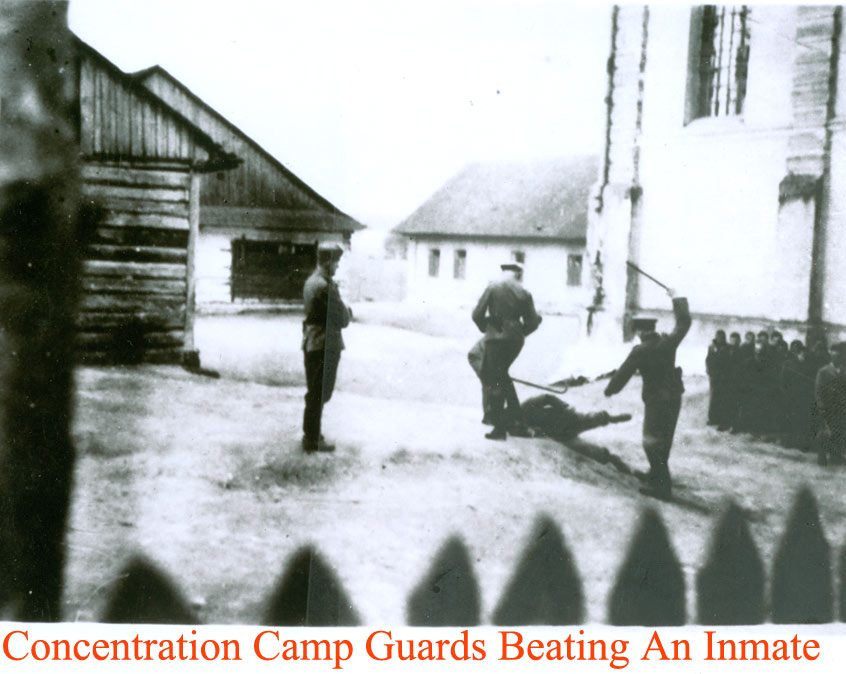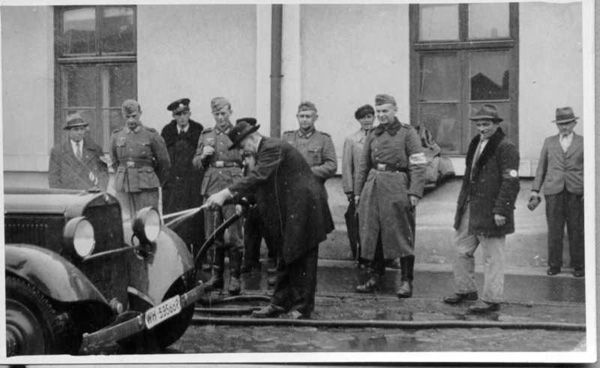|
To go back to Page One of Memorial Click This Link
Here
Besides the beating by the SS-men and overseers at the place of work the following punishments were applied to men and worsen, with the aim of maintaining working discipline among the prisoners: flogging, (penal gymnastics (Strafexerzieren), work under supervision on Sundays and holidays, transfer to a penal group, standing, kneeling with hands up, stones holding, and finally incarceration in a dark narrow cell (Stehzelle).Punishment was based on report by an SS-man, overseer at the place of work or block leader. The punishment was prescribed by the Commandant of the Camp in a written order, by virtue of the disciplinary authority which was given him by the regulations for concentration camps. In the printed form of this regulation the following penalties are laid down: Threat of punishment, work under the supervision of an SS-man during normally free time, a ban on writing or receiving letters, deprivation of dinner with work as usual, transfer to a penal company, and a hard bed in a cell after his daily work. Deprivation of freedom was marked by three grades of arrest. During arrest the prisoner received daily only bread and water, and full diet every fourth day. Third grade had to be endured by the prisoner in a dark cell, so arranged that he could neither lie nor sit. Third grade was known in the language of the camp as "Bunker". It was endured in small dark cement cells, in which the prisoners were so squeezed that they could not move and were obliged to stand the whole time. At Birkenau these cells were entered by a small opening like a dog kennel. This punishment was administered practically in all cases where "hard bed" was ordered. Officially it was called "Stehzelle", and in practice was enhanced by ingenious tortures, such as pouring of water into the ears, beating the heels, pulling out finger nails, or starving for several days after which the prisoner was given vegetable salad specially seasoned with salt for producing a great thirst. A starvation cell was instituted with special sadism by Lagerführer Fritsch, where prisoners were kept who were caught trying to escape. In this cell there were instances of cannibalism. One of the prisoners who was in this cell told of the following scene: "When the door was opened, a horrible smell of decaying corpses was noticeable. After accustoming myself to the darkness, I noticed in a corner the corpse of a prisoner, with his intestines pulled out, and beside him in a half recumbent position- second body, also of a prisoner. He was holding in his hand the liver he had taken from the body of his dead companion. Death struck him in the act of devouring this liver". According to the regulations concerning the administering of punishment by flogging (Körperliche Zuchtigung) the prisoner first had to undergo a medical inspection, and then the punishment was to be applied with a leather whip, with blows following swiftly upon each other. Beating was allowed only on the buttocks, which had to be clad. Further down on the form there is a printed medical certificate form, to the effect that the prisoner underwent a medical inspection before flogging and that from the medical point of view there were no objections to his receiving such a punishment. Afterwards the confirmation of the extent of the punishment by the Chief of ,the Official Group D in Berlin, was included, and a protocol that the punishment was administered, with the names of the prisoners who flogged the delinquent, and the signature of four officers of the SS (the Commander and three functionaries). Flogging was administered publicly during the evening roll-call on a specially constructed whipping block which is seen on the photograph below. Regardless of the above-mentioned regulations the prisoners were beaten on naked buttocks, which as a rule were cut till the blood flowed. Usually this punishment caused tumours on the buttocks sometimes as big as a fist. If the delinquent fainted, he was restored to consciousness and the punishment was continued. The smallest punishment amounted to 10 blows. It was an official punishment. Unofficially the blockleaders flogged the prisoners for the slightest offence usually ordering the prisoners to put their heads into the opening of the stove, and afterwards beating them on the buttocks with a rod. The standing punishment consisted of standing at attention at the camp office near the exit gate of the camp. This punishment was applied in the women’s camp, and lasted from three hours to a whole day, and even several days following each other without a break. During the time it lasted the woman-prisoner did not get anything to eat. If in the punishment of kneeling the woman-delinquent dropped her stone-filled outstretched hands, she was beaten till she lost consciousness. The duration of the punishment by kneeling ,depended on the whim of the authorities, and lasted from two to several hours. The prisoners who formed the penal company always worked in the open air, always on the hardest work, often in water to the waist, and lived in an isolated Block No. XI, at the far end of the camp and in the XI Block of the B II Section in Birkenau. They worked in winter and in summer without socks, in Dutch cloys, clad only in ticking. They received food or not according to the whim of the blockleader. They spent in most cases sleepless nights owing to constant shouting and blows. They were lying without even straw mattresses on the bare floor, and left their rags in prescribed order in the corridor. This Block was not heated. It is obvious that people in such conditions fell ill wholesale. Up to 1943 it was not permissible however to take sick from the penal company into hospital. So the seriously ill, deprived of medical assistance, were doomed in Block XI to death.The greatest percentage perished, however, at the hands of the blockleader of the XI Block-Krankenmann. He used to line up the prisoners by a wall, struck their jaws with his hand, so that they split, and the other side of the head struck the wall and was smashed.Punishments were administered for the slightest offence against the camp regulations, such as not making one’s bed properly, for finding potatoes on the prisoner, who wanted to cook when in his Block or at his place of work, for having in one’s possession family photographs or letters, and particularly for writing and receiving letters from other prisoners within the camp area.
And on the outside living conditions are equally harsh for a Jew.Here we see a Rabbi forced to wash some Germans car.See the German Nazi sadists smile as they force an unarmed defenseless old man to wash their vehicle.
|

